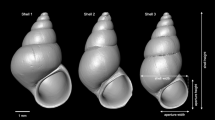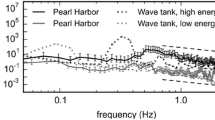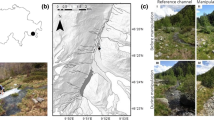Summary
Using Laser Doppler Anemometry we measured current velocities in the median plane around dead lotic macroinvertebrates in a flume which reproduced natural near bottom hydraulics. We investigated specimens of the gastropods Ancylus, Acroloxus, and Potamopyrgus, the amphipod Gammarus, and the larval caddisflies Anabolia, Micrasema, and Silo of various size, various alignment to the flow or which were otherwise manipulated in order to clarify certain questions of adaptation of shape or case building style to flow, or the effects of flow on field distribution patterns. The steepest velocity gradients close to the animals were found near areas of their bodies protruding furthest into the flow. In such regions the rates of potential diffusive exchange processes, the potential corrasion (abrasion through suspended solids), and, for larger specimens, the lift forces (directed towards the water surface) must be highest. Posterior of these areas growing boundary layers formed above those species whose upper contour was approximately parallel to the upstream-downstream direction of the flow. All specimens removed momentum from the flow and thus experience a drag force (directed downstream). From the complete data set we derived the following general conclusions about the physical effects of potential morphological adaptations, taking into consideration diffusion through boundary layers, corrasion, lift forces, friction and pressure drag forces: The physical significance of these five factors generally depends on the Reynolds number of an animal and is largely affected by flow separation, which was significantly related to the ratio of body length to height and the slope of the posterior contour. A simultaneous effective morphological adaptation to all five factors is physically impossible and, in addition, would have to change from life at low (e.g. a young, small specimen of a species) to life at high (e.g. a fully grown specimen of the same species) Reynolds number.
Similar content being viewed by others
Refereces
Ambühl H (1959) Die Bedeutung der Strömung als ökologischer Faktor. Schweiz Z Hydrol 21:133–264
Braimah SA (1987) Pattern of flow around filter-feeding structures of immature Simulium bivittatum Malloch (Diptera: Simuliidae) and Isonychia campestris McDunnough (Ephemeroptera: Oligoneuriidae). Can J Zool 65:514–521
Butz I (1979) Strömungsverhalten von Ecdyonurus venosus (Fabr.) (Ephemeroptera). Proc 2nd Int Conf Ephemeroptera 1975. PAN, Krakow, pp 199–212
Chance MM, Craig DA (1986) Hydrodynamics and behaviour of Simuliidae larvae (Diptera). Can J Zool 64:1295–1309
Craig DA, Chance MM (1982) Filter feeding in larvae of Simuliidae (Diptera: Culicomorpha): aspects of functional morphology and hydrodynamics. Can J Zool 60:712–724
Crowson RA (1981) The biology of the coleoptera. Academic Press, London
Davis JA (1986) Boundary layers, flow microenvironments and stream benthos. In: DeDeckker P, Williams WD ( eds) Limnology in Australia, CSIRO, Melbourne, pp 293–312
Dodds GS, Hisaw FL (1924) Ecological studies of aquatic insects. II. Size of respiratory organs in relation to environmental conditions. Ecology 5:262–271
Dodds GS, Hisaw FL (1925) Ecological studies on aquatic insects. III. Adaptations of caddisfly larvae to swift streams. Ecology 6:123–137
Durst F, Melling A, Whitelaw JH (1981) Principles and practice of Laser-Doppler Anemometry, 2nd edn. Academic, London
Dussart GBJ (1987) Effects of water flow on the detachment of some aquatic pulmonate gastropods. Am Malacol Bull 5:65–72
Eastham LES (1937) The gill movements of nymphal Ecdyonurus venosus (Ephemeroptera) and the currents produced by them in water. J Exp Biol 14:219–228
Eriksen CH, Resh VH, Balling SS, Lamberti GA (1984) Aquatic insect respiration. In: Merritt RW, Cummins KW (eds) An introduction to the aquatic insects of North America, 2nd edn. Kendall/Hunt, Dubuque, pp 27–37
Feldmeth CR (1970) The respiratory energetics of two species of stream caddis fly larvae in relation to water flow. Comp Biochem Physiol 32:193–202
Franke U (1977) Experimentelle Untersuchungen zur Respiration von Gammarus fossarum Koch 1835 (Crustacea — Amphipoda) in Abhängigkeit von Temperatur, Sauerstoffkonzentration und Wasserbewegung. Arch Hydrobiol Suppl 48:369–411
Gallepp G (1974a) Diel periodicity in the behaviour of the caddisfly, Brachycentrus americanus (Banks). Freshwater Biol 4:193–204
Gallepp G (1974b) Behavioral ecology of Brachycentrus occidentalis Banks during the pupation period. Ecology 55:1283–1294
Gore JA (1983) Considerations of size related flow preferences among macroinvertebrates used in instream flow studies. In: Shuval HG (ed) Developments in ecology and environmental quality, vol. 2. Balaban Int Publ, Jerusalem, pp 389–398
Johansson A (1986) Caddisfly cases as anti-predatory devices with special reference to limnephilids. Introduct Res Essay No 2. Dept Anim Ecol, Umea
Maude SH, Williams DD (1983) Behavior of crayfish in water currents: hydrodynamics of eight species with reference to their distribution patterns in southern Ontario. Can J Fish Aquat Sci 40:68–77
McShaffrey D, McCafferty WP (1987) The behaviour and form of Psephenus herricki (DeKay) (Coleoptera: Psephenidae) in relation to water flow. Freshwater Biol 18:319–324
Nachtigall W (1974) Biological mechanisms of attachment. Springer, Berlin Heidelberg New York
Neumann D (19820 Schwachstellen beim Einsatz von Bioindikatoren und weitere Forschungsziele. In: Bick H, Neumann D (eds) Bioindikatoren. Decheniana Beih (Bonn) 26:193–196
Nielsen A (1950) The torrential invertebrate fauna. Oikos 2:176–196
Nowell ARM, Jumars PA (1984) Flow environmens of aquatic benthos. Annu Rev Ecol Syst 15:303–328
Ponyi E (1956) Ökologische, ernährungsbiologische und systematische Untersuchungen an verschiedenen Gammarus-Arten. Arch Hydrobiol 52:367–387
Prandtl L, Oswatitsch K, Wieghardt K (1984) Führer durch die Strömungslehre, 8th edn. Vieweg, Brauschweig
Rees CP (1972) The distribution of the amphipod Gammarus pseudolimnaeus Bousfield as influenced by oxygen concentration, substratum, and current velocity. Trans Am Micros Soc 91:514–529
Ruttner F (1926) Bemerkungen über den Sauerstoffgehalt der Gewässer and dessen respiratorischen Wert. Naturwissenschaften 14:1237–1239
Schade H, Kunz E (1980) Strömungslehre. De Gruyter, Berlin
Schoenemund E (1930) Eintagsfliegen oder Ephemeroptera. Tierwelt Dtschl No 19. Fischer, Jena
Schwenk W, Schwoerbel J (1973) Untersuchungen zur Ernährungsbiologie und Lebensweise der Flußmützenschnecke Ancylus fluviatilis (O.F. Müller 1774; Gastropoda Basommatophora). Arch Hydrobiol Suppl 42:190–231
Smith JA, Dartnall AJ (1980) Boundary layer control by water pennies (Coleoptera: Psephenidae). Aquat Insects 2:65–72
Statzner B (1981) The relation between “hydraulic stress” and microdistribution of benthic macroinvertebrates in a lowland running water system, the Schierenseebrooks (North Germany). Arch Hydrobiol 91:192–218
Statzner B (1987) Ökologische Bedeutung der sohlennahen Strömungsgeschwindigkeit für benthische Wirbellose in Fließgewässern. Habil-Thesis, Univ Karlsruhe
Statzner B (1988) Growth and Reynolds number of lotic macroinvertebrates: a problem for adaptation of shape to drag. Oikos 51:84–87
Statzner B, Bittner A (1983) Nature and causes of migrations of Gammarus fossarum Koch (Amphipoda) — a field study using a light intensifier for the detection of nocturnal activities. Crustaceana 44:271–291
Statzner B, Holm TF (1982) Morphological adaptations of benthic invertebrates to stream flow — an old question studied by means of a new technique (Laser Doppler Anemometry). Oecologia 53:290–292
Statzner B, Mogel R (1984) No relationship between the substrate surface densities and drift of the stream caddisfly Micrasema longulum (Brachycentridae, Trichoptera) In: Morse JC (ed) Proc 4th Int Symp Trichoptera. Junk, The Hague, pp 383–389
Steinmann P (1907) Die Tierwelt der Gebirgsbäche. Annls Biol Lacustre 2:30–150
St. Quentin D, Beier M (1968) Odonata (Libellen). Handb Zool 4(2)2/6:1–39
Streit B (1980) Ökologie. Thieme, Stuttgart
Streit B (1981) Food searching and exploitation by a primary consumer (Ancylus fluviatilis) in a stochastic environment: nonrandom movement patterns. Rev Suisse Zool 88:887–895
Sutcliffe DW (1984) Quantitative aspects of oxygen uptake by Gammarus (Crustacea, Amphipoda): a critical review. Freshwater Biol 14:443–489
Vogel S (1981) Life in moving fluids. Grant, Boston
Webster DA, Webster PC (1943) Influence of water current on case weight in larvae of the caddisfly, Goera calcarata Banks. Can Entomol 75:105–108
Weissenberger J (1987) Messung der Schub- und Auftriebskräfte an benthischen Wirbellosen der Fließgewässer. Dipl.-Thesis, Univ Freiburg
Wesenberg-Lund C (1943) Biologie der Süßwasserinsekten. Gyldendalske/Springer, Kopenhagen/Berlin
Wiggins GB (1977) Larvae of the North American caddis fly genera (Trichoptera). Univ Press, Toronto
Zwick P (1980) Plecoptera (Steinfliegen). Handb Zool 4(2)2/7:1–111
Author information
Authors and Affiliations
Rights and permissions
About this article
Cite this article
Statzner, B., Holm, T.F. Morphological adaptation of shape to flow: Microcurrents around lotic macroinvertebrates with known Reynolds numbers at quasi-natural flow conditions. Oecologia 78, 145–157 (1989). https://doi.org/10.1007/BF00377150
Received:
Issue Date:
DOI: https://doi.org/10.1007/BF00377150




